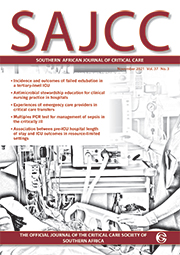Articles

Evaluation of a protocol to control methicillin resistant Staphylococcus aureus (MRSA) in a surgical cardiac intensive care unit
Abstract
Methicillin Resistant Staphylococcus aureus (MRSA) is a major healthcare problem related to morbidity and mortality in Intensive Care Units1.
Purpose
To evaluate how nurses implement the Methicillin Resistant Staphylococcus aureus Protocol (MRSAP) in a surgical cardiac intensive care unit (SCICU), and to evaluate the change in MRSA infection rates following the implementation of the protocol.
Methods
The knowledge of nursing staff and their compliance to the MRSAP were assessed using a survey questionnaire and by conducting observations in the unit. Screening compliance and the reduction in infection rates were investigated using a retrospective records review.
Results
There was an 88% (23) awareness of the MRSAP, but knowledge of the detailed content was variable. Staff were satisfied with the existing standards of infection control in SCICU (84.6%, 22) and compliance with routine hygiene measures, such as hand hygiene, equated to 64% (144). Inadequate data in sampled records prevented meaningful analysis of screening compliance. The change in infection rates between pre and post MSAP periods in a SCICU, which incorporated use of infection risk stratification data to demonstrate comparability of the two groups of patients, revealed that despite the high MRSA infection rate in 2005 (1.18%), and subsequent drop post MRSAP (0.35%), the actual number of cases found was too small to test statistically for significant difference. There was also a significant decrease in MRSA infection rates in the hospital for matched periods (p<0.0001).
Conclusions
There was evidence to support the efficacy of the MRSAP in the reduction of MRSA infections.
Purpose
To evaluate how nurses implement the Methicillin Resistant Staphylococcus aureus Protocol (MRSAP) in a surgical cardiac intensive care unit (SCICU), and to evaluate the change in MRSA infection rates following the implementation of the protocol.
Methods
The knowledge of nursing staff and their compliance to the MRSAP were assessed using a survey questionnaire and by conducting observations in the unit. Screening compliance and the reduction in infection rates were investigated using a retrospective records review.
Results
There was an 88% (23) awareness of the MRSAP, but knowledge of the detailed content was variable. Staff were satisfied with the existing standards of infection control in SCICU (84.6%, 22) and compliance with routine hygiene measures, such as hand hygiene, equated to 64% (144). Inadequate data in sampled records prevented meaningful analysis of screening compliance. The change in infection rates between pre and post MSAP periods in a SCICU, which incorporated use of infection risk stratification data to demonstrate comparability of the two groups of patients, revealed that despite the high MRSA infection rate in 2005 (1.18%), and subsequent drop post MRSAP (0.35%), the actual number of cases found was too small to test statistically for significant difference. There was also a significant decrease in MRSA infection rates in the hospital for matched periods (p<0.0001).
Conclusions
There was evidence to support the efficacy of the MRSAP in the reduction of MRSA infections.
Authors' affiliations
Karen Kindness, RN, M Nursing (Critical Care & Trauma), Cardiothoracic ICU
Petra Brysiewicz, University of KwaZulu-Natal
Full Text
Keywords
Evaluation, Methicillin Resistant Staphylococcus aureus (MRSA), Infection control, Surgical Cardiac Intensive Care Unit
Cite this article
Southern African Journal of Critical Care 2010;26(1):11.
Article History
Date submitted: 2009-08-17
Date published: 2010-08-19
Date published: 2010-08-19
Article Views
Abstract views: 4057
Full text views: 1380
Full text views: 1380




1.jpg)
Comments on this article
*Read our policy for posting comments here